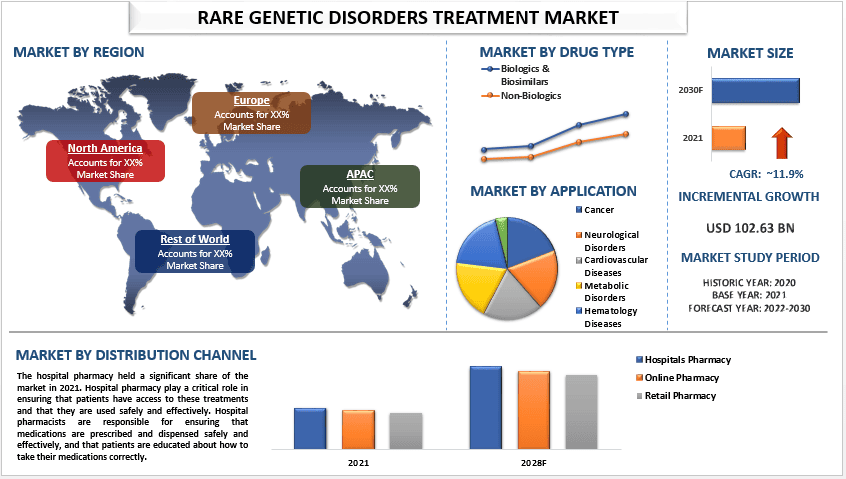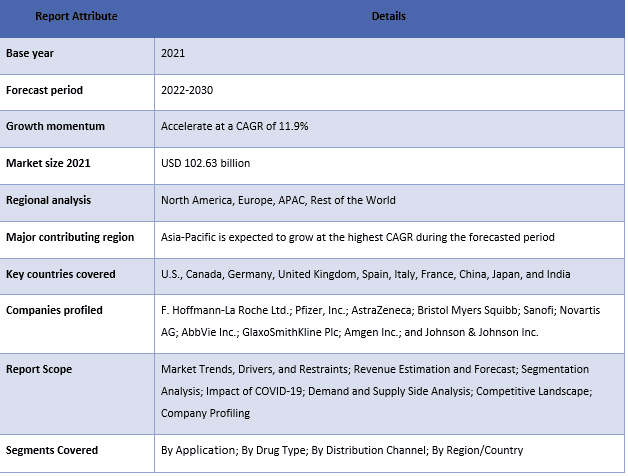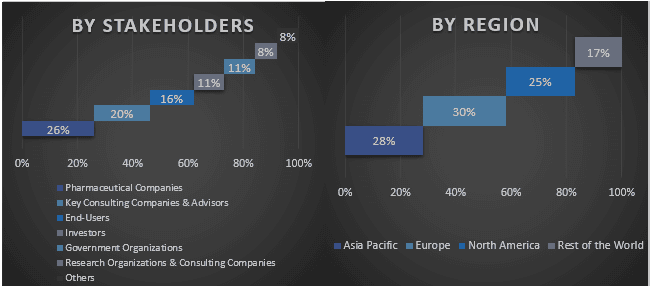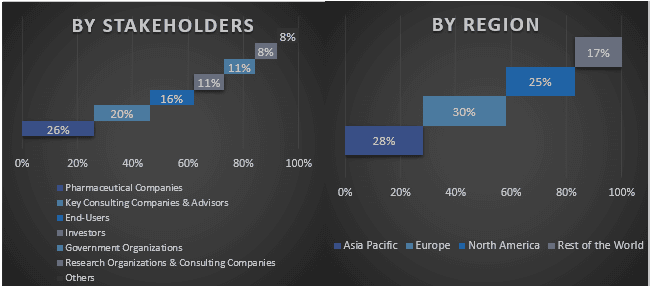Emphasis on Applicaton (Cancer, Neurological Disorders, Cardiovascular Diseases, Metabolic Disorders, Hematology Diseases, and Others); Drug Type (Biologics & Biosimilars, and Non-Biologics); Distribution Channel (Hospital Pharmacy, Online Pharmacy, and Retail Pharmacy); Region/Country.

The rare genetic disorders treatment market is expected to grow at a strong CAGR of around 11.9% during the forecast period. The increase in research and development spending by major key pharmaceutical players in the market is another factor influencing the growth of the market. Because public awareness and comprehension of rare diseases have grown, a number of significant clinical-stage biopharmaceutical startups and established market players now have orphan drug pipeline candidates in various phases of clinical trials. For instance, in 2021, Biogen acquired TMS-007, a preclinical gene therapy for Friedreich’s ataxia, a rare genetic disease that affects the nervous system. Biogen also announced plans to acquire GSK’s rare disease unit for USD 5.1 billion, which includes several drugs for rare genetic diseases such as Hunter syndrome and Morquio syndrome.
Some of the major players operating in the market include F. Hoffmann-La Roche Ltd.; Pfizer, Inc.; AstraZeneca; Bristol Myers Squibb; Sanofi; Novartis AG; AbbVie Inc.; GlaxoSmithKline Plc; Amgen Inc.; and Johnson & Johnson Inc. Several M&As along with partnerships have been undertaken by these players to facilitate customers with hi-tech and innovative products/technologies.
Insights Presented in the Report
“Amongst application, the neurological disorders segment to grow with high CAGR during the forecast period”
Based on application, the market is segmented into cancer, neurological disorders, cardiovascular diseases, metabolic disorders, hematology diseases, and others. The neurological disorders segment is expected to grow with high CAGR during the forecast period. Neurological diseases are a common type of rare genetic disorder, with an estimated prevalence of 350 million people worldwide. This high prevalence has driven research and development efforts in this area. Rare neurological diseases are caused by genetic mutations that affect the brain and nervous system. Some examples include Huntington’s disease, spinal muscular atrophy, and Niemann-Pick disease. For instance, according to the National Institutes of Health (NIH), Spinal Muscular Atrophy (SMA) is a rare genetic disease that affects the nervous system, causing muscle weakness and atrophy. The rising number of product approvals for rare genetic disorders is driving the growth of the segment. For instance, Evrysdi is a small molecule drug that was approved by the FDA in 2020 for the treatment of SMA.
“Amongst drug type, the non-biologics category to grow with high CAGR during the forecast period”
By drug type, the market is bifurcated into biologics & biosimilars, and non-biologics. The non-biologics category is anticipated to grow with high CAGR during the forecast period. Non-biologics therapy for rare genetic disorders is a growing area of interest in the field of medicine. Unlike biologics, which are made from living cells or organisms, non-biologics are chemical compounds that are synthesized in a laboratory. They can be small molecules, peptides, or nucleic acid-based therapies, and they are often more stable and easier to produce than biologics. The market for non-biologics therapy for rare genetic disorders is expected to grow significantly in the coming years, as more therapies are developed and approved for use. For instance, in December 2020, the US FDA approved Oxlumo (lumasiran) for the treatment of primary hyperoxaluria type 1 (PH1), a rare genetic disorder that can cause kidney damage and failure. Another, in November 2020, the US FDA approved lumasiran for the treatment of primary hyperoxaluria type 1 (PH1), a rare genetic disorder that can cause kidney damage and failure.
Rare Genetic Disorders Treatment Market Report Coverage

“Amongst distribution channel, the hospital pharmacy category held a significant share of the market in 2021”
By distribution channel, the market is segmented into hospital pharmacy, online pharmacy, and retail pharmacy. The hospital pharmacy held a significant share of the market in 2021. Hospital pharmacy play a critical role in ensuring that patients have access to these treatments and that they are used safely and effectively. Hospital pharmacists are responsible for ensuring that medications are prescribed and dispensed safely and effectively, and that patients are educated about how to take their medications correctly. Moreover, these are also involved in clinical research and development. Many hospitals participate in clinical trials to test new orphan drugs and to gather data on the safety and efficacy of these treatments.
“North America held dominant share of the market in 2021”
In 2021, North America held a dominant share of the market. The growing demand for rare genetic disorders treatments can be attributed due to the surge in the prevalence of rare cancers and other diseases. According to an article shared by the American Cancer Society, in the US in January 2022, there are approximately 54,000 new cases of oropharyngeal or oral cancer each year. Oropharyngeal or oral cancer claims the lives of 11,230 people. Moreover, rising healthcare expenditure is also acting as a major driver for the growth of the market in the region.
Reasons to buy this report:
Customization Options:
The global rare genetic disorders treatment market can further be customized as per the requirement or any other market segment. Besides this, UMI understands that you may have your own business needs, hence feel free to connect with us to get a report that completely suits your requirements.
1. Market Introduction
2. Research Methodology Or Assumption
3. Market Synopsis
4. Executive Summary
5. Global Rare Genetic Disorders Treatment Market Covid-19 Impact
6. Global Rare Genetic Disorders Treatment Market Revenue, 2019-2027f
7. Market Insights By Application
8. Market Insights By Drug Type
9. Market Insights By Distribution Channel
10. Market Insights By Region
11. Rare Genetic Disorders Treatment Market Dynamics
12. Rare Genetic Disorders Treatment Market Opportunities
13. Rare Genetic Disorders Treatment Market Trends
14. Demand And Supply-side Analysis
15. Value Chain Analysis
16. Price Analysis
17. Competitive Scenario
18. 18 Company Profiled
19. Disclaimer
Research Methodology for the Rare Genetic Disorders Treatment Market Analysis (2022-2030)
Analyzing the historical market, estimating the current market, and forecasting the future market of the global rare genetic disorders treatment market were the three major steps undertaken to create and analyze the adoption of rare genetic disorders treatment in major regions globally. Exhaustive secondary research was conducted to collect the historical market numbers and estimate the current market size. Secondly, to validate these insights, numerous findings and assumptions were taken into consideration. Moreover, exhaustive primary interviews were also conducted, with industry experts across the value chain of the global rare genetic disorders treatment market. Post assumption and validation of market numbers through primary interviews, we employed a top-down/bottom-up approach to forecasting the complete market size. Thereafter, market breakdown and data triangulation methods were adopted to estimate and analyze the market size of segments and sub-segments of the industry pertains to. Detailed methodology is explained below:
Analysis of Historical Market Size
Step 1: In-Depth Study of Secondary Sources:
Detail secondary study was conducted to obtain the historical market size of the rare genetic disorders treatment market through company internal sources such as annual reports & financial statements, performance presentations, press releases, etc., and external sources including journals, news & articles, government publications, competitor publications, sector reports, third-party database, and other credible publications.
Step 2: Market Segmentation:
After obtaining the historical market size of the rare genetic disorders treatment market, we conducted a detailed secondary analysis to gather historical market insights and share for different segments & sub-segments for major regions. Major segments are included in the report as application, drug type, and distribution channel. Further country-level analyses were conducted to evaluate the overall adoption of testing models in that region.
Step 3: Factor Analysis:
After acquiring the historical market size of different segments and sub-segments, we conducted a detailed factor analysis to estimate the current market size of the rare genetic disorders treatment market. Further, we conducted factor analysis using dependent and independent variables such as application, drug type, and distribution channel of the rare genetic disorders treatment market. A thorough analysis was conducted for demand and supply-side scenarios considering top partnerships, mergers and acquisitions, business expansion, and product launches in the rare genetic disorders treatment market sector across the globe.
Current Market Size Estimate & Forecast
Current Market Sizing: Based on actionable insights from the above 3 steps, we arrived at the current market size, key players in the global rare genetic disorders treatment market, and market shares of the segments. All the required percentage shares split, and market breakdowns were determined using the above-mentioned secondary approach and were verified through primary interviews.
Estimation & Forecasting: For market estimation and forecast, weights were assigned to different factors including drivers & trends, restraints, and opportunities available for the stakeholders. After analyzing these factors, relevant forecasting techniques i.e., the top-down/bottom-up approach were applied to arrive at the market forecast for 2030 for different segments and sub-segments across the major markets globally. The research methodology adopted to estimate the market size encompasses:
Market Size and Share Validation
Primary Research: In-depth interviews were conducted with the Key Opinion Leaders (KOLs) including Top Level Executives (CXO/VPs, Sales Head, Marketing Head, Operational Head, Regional Head, Country Head, etc.) across major regions. Primary research findings were then summarized, and statistical analysis was performed to prove the stated hypothesis. Inputs from primary research were consolidated with secondary findings, hence turning information into actionable insights.
Split of Primary Participants in Different Regions

Market Engineering
The data triangulation technique was employed to complete the overall market estimation and to arrive at precise statistical numbers for each segment and sub-segment of the global rare genetic disorders treatment market. data was split into several segments & sub-segments post studying various parameters and trends in the areas of the application, drug type, and distribution channel in the global rare genetic disorders treatment market.
The main objective of the Global Rare Genetic Disorders Treatment Market Study
The current & future market trends of the global rare genetic disorders treatment market were pinpointed in the study. Investors can gain strategic insights to base their discretion for investments on the qualitative and quantitative analysis performed in the study. Current and future market trends determined the overall attractiveness of the market at a regional level, providing a platform for the industrial participant to exploit the untapped market to benefit from a first-mover advantage. Other quantitative goals of the studies include:

Customers who bought this item also bought